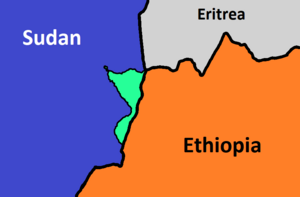| Al-Fashaga conflict | |||||||
|---|---|---|---|---|---|---|---|
| Part of Spillover of the Tigray War | |||||||
 The al-Fashaga triangle (light green), near the tripoint of the borders of Sudan (blue), Ethiopia (orange), and Eritrea (grey) | |||||||
| |||||||
| Belligerents | |||||||
|
|
Alleged: | ||||||
| Commanders and leaders | |||||||
|
| Unknown | ||||||
| Strength | |||||||
|
| Unknown | ||||||
| Casualties and losses | |||||||
|
97 servicemen killed[7][8] 17 captured[9][10] 1 Mil Mi-24 lost[11] |
Unknown killed 53 captured[12] | ||||||
| At least 11 civilians killed (Sudanese claim)[13][14][15][16] | |||||||
The Al-Fashaga conflict was a conflict between Sudan and Amhara militants from Ethiopia in the disputed border region of al-Fashaga (an area of Sudan east of the Atbarah River and south of the Tekezé River).[17] Since 2008, Ethiopia has dropped all claims to the al-Fashaga as long as Sudan allowed Ethiopian farmers and militants to stay in the area undisturbed. With the outbreak of the Tigray War, Sudanese forces were able to move into the region due to an agreement with Ethiopia just three days before. When Amhara militants left to assist the federal government in the war, Sudanese forces started to drive out Ethiopian farmers, effectively breaking the 2008 compromise. Ethiopia has also accused Sudan of killing Amhara farmers.[18][19] The Government of Sudan claims the involvement of ENDF and Eritrean troops in the border dispute while the Ethiopian government denies this and regards the conflict as skirmishes between Sudanese forces and ethnic militias from the Amhara region. External media coverage has tended to conflate the Amhara militias with federal soldiers from the Ethiopian National Defence Forces (ENDF). There is some evidence to suggest that the ENDF has been involved in the conflict, although the capacity in which they are doing so is unclear. It is likely that they have had a peripheral role in the actual fighting.[20]
In 2007 Sudan and Ethiopia signed a treaty which will allow Ethiopian farmers to stay in Al-Fashaga and keep cultivate the land. After more than a decade which the treaty remain, in 2020 when the Tigray war broke, Sudan’s army took advantage of the fact that Amhara militiamen and Ethiopian military were deployed north as result, and broke the treaty by invading Al-Fashaga and expelling thousands of Amhara farmers from their home.[21][22][23]
- ^ "Eritrea Forces Deployed in Disputed Sudan-Ethiopia Area, UN Says". Bloomberg News. 24 March 2021.
- ^ "Sudan regains full control of border with Ethiopia: Ministry". Al Jazeera. 31 December 2020.
- ^ "Sudanese army deployed along the disputed border with Ethiopia". Africanews.com. 15 December 2021.
- ^ "Sudan, Ethiopia agreed to settle all disputes peacefully". Sudan Tribune. 1 December 2022. Archived from the original on 2 December 2022. Retrieved 3 December 2022.
- ^ Cite error: The named reference
SudanTwas invoked but never defined (see the help page). - ^ Cite error: The named reference
:3was invoked but never defined (see the help page). - ^ "Sudan accuses Ethiopia of executing Sudanese soldiers, a civilian". Reuters. 27 June 2022. Retrieved 27 June 2022.
- ^ "Ethiopia army carries out fresh attacks on Sudanese border strip". Sudan Tribune. 28 November 2021. Archived from the original on 30 November 2021. Retrieved 29 November 2021.
- ^ Belmonte, Nerea. "Ethiopia and Sudan exchange 62 prisoners captured during border dispute over Al-Fashaga". Retrieved 8 July 2023.
The exchange of 62 prisoners between the Sudanese armed forces and their Ethiopian counterpart at the Al Qalabat Pass - close to the line separating the two countries - has made this clear. The press release issued by Sudan after the operation on Monday gave details of the exchange: the parties, meeting in Matamah under the auspices of the international Red Cross, handed over the 62 prisoners - 53 soldiers and Ethiopians and nine Sudanese individuals
- ^ "Red Lines: Upheaval and Containment in the Horn of Africa". 22 December 2021.
Eight captured Sudanese soldiers were returned to Sudan by the ENDF on 17 January
- ^ "Sudanese military helicopter crashes near Ethiopian border". AP NEWS. 13 January 2021. Retrieved 4 February 2021.
- ^ Belmonte, Nerea (22 December 2021). "Ethiopia and Sudan exchange 62 prisoners captured during border dispute over Al-Fashaga".
- ^ "Sudan says Ethiopian military plane crossed its border". www.aljazeera.com. Retrieved 14 January 2021.
- ^ "Situation Report EEPA Horn No. 46 – 5 January 2021" (PDF). Europe External Programme with Africa.
- ^ "هجوم اثيوبي جديد يقود إلى استشهاد رعاة سودانيين بمحلية القلابات الشرقية". اخبار السودان (in Arabic). 18 January 2021. Archived from the original on 18 January 2021. Retrieved 31 January 2021.
- ^ "Sudan closes border crossing with Ethiopia after disappearance of commander". ARAB NEWS. 24 July 2021.
- ^ Bearak, Max (19 March 2021). "A border war looms between Sudan and Ethiopia as Tigray conflict sends ripples through region". Washington Post. ISSN 0190-8286. Archived from the original on 25 March 2023. Retrieved 27 June 2021.
- ^ Cite error: The named reference
:0was invoked but never defined (see the help page). - ^ Cite error: The named reference
:2was invoked but never defined (see the help page). - ^ "AL FASHAGA BORDER DISPUTE". epo.acleddata.com.
- ^ "Containing the Volatile Sudan-Ethiopia Border Dispute". Crisis Group. 24 June 2021. Retrieved 25 July 2021.
- ^ "Sudan and Ethiopia's dispute in fertile border area threatens regional stability". Middle East Eye. 2 July 2021. Retrieved 6 August 2021.
- ^ "Why nerves are jangling on the border between Ethiopia and Sudan". The Economist. 15 July 2021. ISSN 0013-0613. Retrieved 16 July 2021.